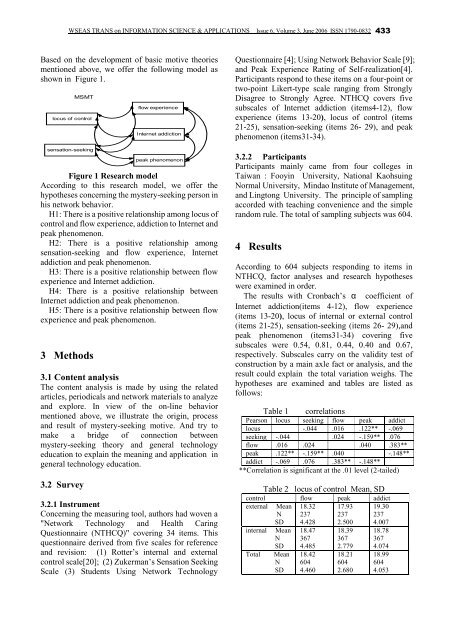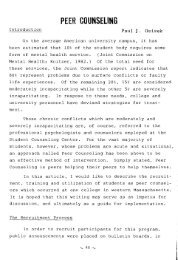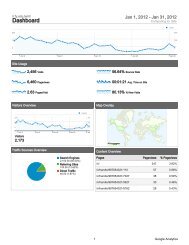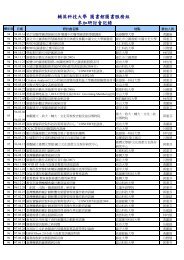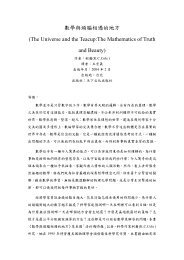Title of the Paper (18pt Times New Roman, Bold)
Title of the Paper (18pt Times New Roman, Bold)
Title of the Paper (18pt Times New Roman, Bold)
Create successful ePaper yourself
Turn your PDF publications into a flip-book with our unique Google optimized e-Paper software.
WSEAS TRANS on INFORMATION SCIENCE & APPLICATIONS Issue 6, Volume 3, June 2006 ISSN 1790-0832 433<br />
Based on <strong>the</strong> development <strong>of</strong> basic motive <strong>the</strong>ories<br />
mentioned above, we <strong>of</strong>fer <strong>the</strong> following model as<br />
shown in Figure 1.<br />
MSMT<br />
locus <strong>of</strong> control<br />
sensation-seeking<br />
flow experience<br />
Internet addiction<br />
peak phenomenon<br />
Figure 1 Research model<br />
According to this research model, we <strong>of</strong>fer <strong>the</strong><br />
hypo<strong>the</strong>ses concerning <strong>the</strong> mystery-seeking person in<br />
his network behavior.<br />
H1: There is a positive relationship among locus <strong>of</strong><br />
control and flow experience, addiction to Internet and<br />
peak phenomenon.<br />
H2: There is a positive relationship among<br />
sensation-seeking and flow experience, Internet<br />
addiction and peak phenomenon.<br />
H3: There is a positive relationship between flow<br />
experience and Internet addiction.<br />
H4: There is a positive relationship between<br />
Internet addiction and peak phenomenon.<br />
H5: There is a positive relationship between flow<br />
experience and peak phenomenon.<br />
3 Methods<br />
3.1 Content analysis<br />
The content analysis is made by using <strong>the</strong> related<br />
articles, periodicals and network materials to analyze<br />
and explore. In view <strong>of</strong> <strong>the</strong> on-line behavior<br />
mentioned above, we illustrate <strong>the</strong> origin, process<br />
and result <strong>of</strong> mystery-seeking motive. And try to<br />
make a bridge <strong>of</strong> connection between<br />
mystery-seeking <strong>the</strong>ory and general technology<br />
education to explain <strong>the</strong> meaning and application in<br />
general technology education.<br />
3.2 Survey<br />
3.2.1 Instrument<br />
Concerning <strong>the</strong> measuring tool, authors had woven a<br />
"Network Technology and Health Caring<br />
Questionnaire (NTHCQ)" covering 34 items. This<br />
questionnaire derived from five scales for reference<br />
and revision: (1) Rotter’s internal and external<br />
control scale[20]; (2) Zukerman’s Sensation Seeking<br />
Scale (3) Students Using Network Technology<br />
Questionnaire [4]; Using Network Behavior Scale [9];<br />
and Peak Experience Rating <strong>of</strong> Self-realization[4].<br />
Participants respond to <strong>the</strong>se items on a four-point or<br />
two-point Likert-type scale ranging from Strongly<br />
Disagree to Strongly Agree. NTHCQ covers five<br />
subscales <strong>of</strong> Internet addiction (items4-12), flow<br />
experience (items 13-20), locus <strong>of</strong> control (items<br />
21-25), sensation-seeking (items 26- 29), and peak<br />
phenomenon (items31-34).<br />
3.2.2 Participants<br />
Participants mainly came from four colleges in<br />
Taiwan : Fooyin University, National Kaohsuing<br />
Normal University, Mindao Institute <strong>of</strong> Management,<br />
and Lingtong University. The principle <strong>of</strong> sampling<br />
accorded with teaching convenience and <strong>the</strong> simple<br />
random rule. The total <strong>of</strong> sampling subjects was 604.<br />
4 Results<br />
According to 604 subjects responding to items in<br />
NTHCQ, factor analyses and research hypo<strong>the</strong>ses<br />
were examined in order.<br />
The results with Cronbach’s α coefficient <strong>of</strong><br />
Internet addiction(items 4-12), flow experience<br />
(items 13-20), locus <strong>of</strong> internal or external control<br />
(items 21-25), sensation-seeking (items 26- 29),and<br />
peak phenomenon (items31-34) covering five<br />
subscales were 0.54, 0.81, 0.44, 0.40 and 0.67,<br />
respectively. Subscales carry on <strong>the</strong> validity test <strong>of</strong><br />
construction by a main axle fact or analysis, and <strong>the</strong><br />
result could explain <strong>the</strong> total variation weighs. The<br />
hypo<strong>the</strong>ses are examined and tables are listed as<br />
follows:<br />
Table 1 correlations<br />
Pearson locus seeking flow peak addict<br />
locus -.044 .016 .122** -.069<br />
seeking -.044 .024 -.159** .076<br />
flow .016 .024 .040 .383**<br />
peak .122** -.159** .040 -.148**<br />
addict -.069 .076 .383** -.148**<br />
**Correlation is significant at <strong>the</strong> .01 level (2-tailed)<br />
Table 2 locus <strong>of</strong> control Mean, SD<br />
control flow peak addict<br />
external Mean<br />
N<br />
SD<br />
18.32<br />
237<br />
4.428<br />
17.93<br />
237<br />
2.500<br />
19.30<br />
237<br />
4.007<br />
internal<br />
Total<br />
Mean<br />
N<br />
SD<br />
Mean<br />
N<br />
SD<br />
18.47<br />
367<br />
4.485<br />
18.42<br />
604<br />
4.460<br />
18.39<br />
367<br />
2.779<br />
18.21<br />
604<br />
2.680<br />
18.78<br />
367<br />
4.074<br />
18.99<br />
604<br />
4.053


